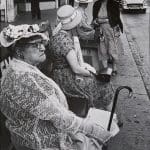
Passages – Family No. 3, 2002
Color pigment print on watercolor paper
Purchase, Museum of Contemporary Art, Chicago, August 2007
February 2-April 29, 2018
Atrium Gallery, Marshall Fine Art Center
Opening Reception: Friday, Feb. 2, from 5:00 p.m. to 7:00 p.m. in the gallery
The word “photography” means writing or drawing with light; the ability to create mimetic images solely by the action of light. This process—part science and part art—was greeted with much enthusiasm and wonder upon its introduction in 1839 by co-inventors, Louis Jacques Mandé Daguerre in France and William Henry Fox Talbot in England. But the inability of these earliest photographic processes to record full color spectrum light was noticeable and regrettable from their introduction.
The search for a manufacturing process to produce full color spectrum photographs upon exposure to light was not achieved until Eastman Kodak in America introduced Kodachrome transparency film in 1935 and Agfa Gevaert in Germany introduced Agfa Color-Neu transparency film in 1936. By the late 1950s the technology to shoot in color was widely available to professionals and amateurs alike, however the prevailing sentiment of the era was that color photography was not artistic, or, as photographer Robert Frank wrote in 1958, “Black and white are the colors of photography.” Recognition of color photography as an art form didn’t begin until decades later with William Eggleston’s 1976 exhibition at the Museum of Modern Art in New York City, which stunned critics with its negation of black-and-white techniques.
A new exhibition at Haverford College’s Atrium Gallery, A Survey of Color Photography from its Prehistory to the Present Day, chronicles this story via 75 representative photographs and related material from the College’s Collection of Photography. A diverse group of photographers, photographs, and processes from the Daguerreian era (1839 to 1855) to today’s digital era take viewers on a tour of color photography’s history, demonstrating how color photography has grown to become the norm when it was once the exception.
The earliest examples in the exhibition include a Daguerreotype by Antoine Claudet and hand-painted albumin prints of scenes from the American West and Japan from the latter half of the 19th century, which required skilled artists to add color to provide a more life-like appearance. Harold Edgerton’s high-speed color photographs—the first ever made, thanks to a donation of Kodachrome film from its inventor—are also on display, as is Edgerton’s seminal book Flash, 1939, which contains representative examples of that work. First edition books by William Eggleston, including the catalog for his 1976 MoMA show, and Stephen Shore’s Uncommon Places are also on view.
The exhibit also showcases the history of digital color photography from “Voodoo Child,” Thomas Porett’s 1980 benchmark for how far this medium has come, to recent works by Zoe Strauss, Shane Lavalette, Kelli Conell, and Misty Keasler.
This exhibit is the first show of this type, featuring only color photography, at Haverford College. Its 75 photographs were selected from 440 color prints in the College’s collection of over 5,000 fine art photographs that survey the field of photography from its origins to the present day.
Press
Philly.com: In Philly galleries now: 3 knockout on-campus art shows
Haverford College’s terrific collection of photographs extends across the history of the medium. That includes, of course, the history of color photography, which began with Eastman Kodak’s Kodachrome transparency film in America in 1935 and Agfa Gevaert’s Color-Neu transparency film in Germany in 1936. Continue »





